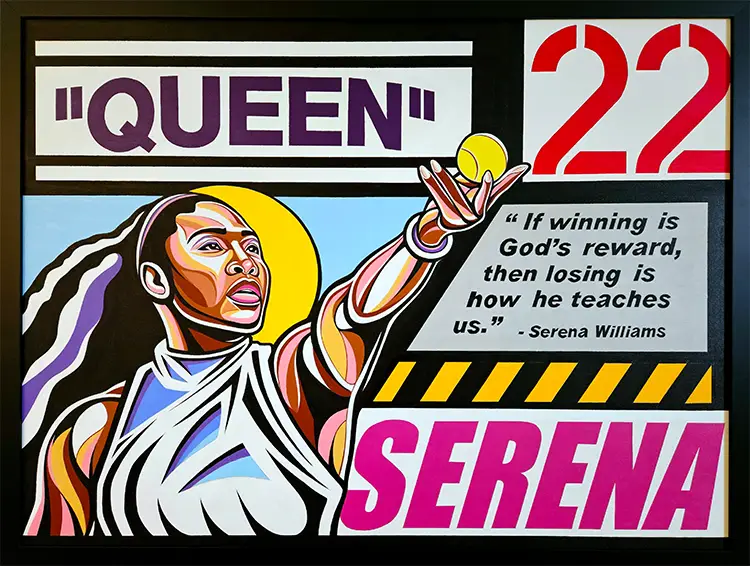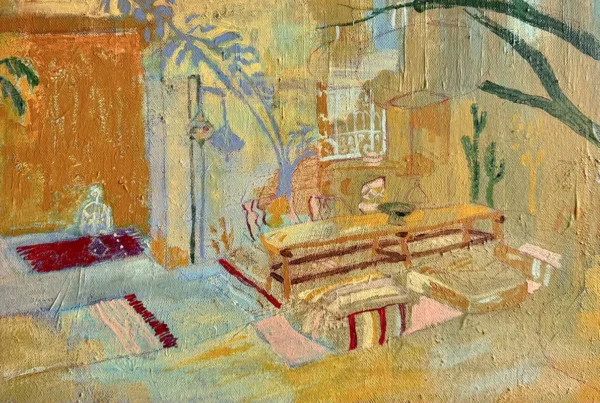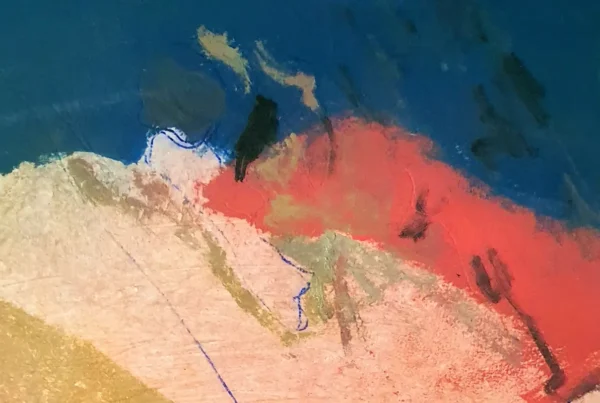“My goal was to create work that visually had style but also had substance.”
Visual Testimony: Memory, Media, and the Making of a Painter
Michael E. Johnson’s work exists at the intersection of nostalgia and cultural critique, where the vibrancy of Pop Art collides with the depth of historical storytelling. As a painter deeply invested in honoring Black American trailblazers, Johnson builds a bridge between the bold visuals of mass media and the overlooked narratives of American culture. His visual language is informed by the visual saturation of his youth during the 1980s and 1990s—a period defined by the booming influence of advertising, television, and consumer branding. This cultural immersion sparked his fascination with visual storytelling and planted the seeds of a style that would grow to celebrate not just aesthetics, but the unsung heroes shaping America’s cultural legacy.
From posters and comic books to album covers and fast food packaging, Johnson’s formative years were filled with imagery that left a lasting imprint on his creative psyche. He found inspiration not only in the design of these materials but also in their ability to capture attention and deliver a message within seconds. This sparked a desire to create art that was as compelling as the consumer graphics that surrounded him but infused with deeper narratives. His paintings embody this duality—flashy, eye-catching forms paired with cultural insight. His compositions function like visual time capsules, filled with the colors, textures, and personalities that shaped his early imagination.
Central to Johnson’s mission is the act of chronicling. Each canvas becomes a tribute to Black Americans whose contributions to popular culture have often been marginalized or diluted. By embedding these figures within visually magnetic compositions, Johnson not only celebrates their impact but reclaims the visual stage on which their legacies belong. His aim is not to simply recreate a nostalgic past, but to reframe it—filtering childhood memory and media influence through the lens of adulthood to craft works that invite conversation, remembrance, and recognition.
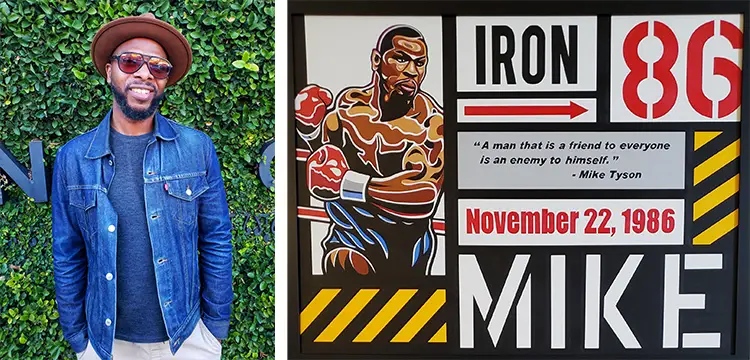
Michael E. Johnson: Between the Graphic and the Groundbreaking
Johnson’s evolution as an artist took shape during his collegiate years at Prairie View A&M University, a pivotal chapter that transformed his lifelong passion into a serious pursuit. Arriving at college without a declared major, he was still driven by a persistent need to draw. Sketching everything from cartoon mascots to advertising icons, he found that art remained the one discipline that consistently held his interest. Although initially hesitant to commit to an art degree, he ultimately joined the Advertising Art Program, a decision that aligned his natural talents with a formal structure. It wasn’t just a shift in academic direction—it was the moment Johnson recognized that art could be more than a hobby; it could be a way of life.
Once enrolled in the program, Johnson began to sharpen both his technical abilities and conceptual focus. The art courses exposed him to graphic design principles and visual communication strategies, helping him understand how to convey complex messages through concise visuals. More than just mastering technique, he began to see art as a tool for storytelling—one capable of shaping perceptions and igniting dialogue. This period also marked the birth of his signature approach: an aesthetic blend of commercial polish and personal narrative, designed not just to please the eye, but to provoke thought. His goal became clear—to produce work that balanced flair with depth, style with substance.
Johnson’s commitment to visibility and representation emerged more clearly as his practice matured. His paintings began to champion figures he considered cultural pioneers—those who shaped American identity but were often confined to footnotes. He wasn’t just building portraits; he was building visual monuments. From the strong lines to the deliberate color palettes, every choice was rooted in a desire to affirm the influence of Black American figures within mainstream culture. His art became a canvas for reclamation, merging pop sensibilities with cultural respect in a way that resonates across generations and backgrounds.
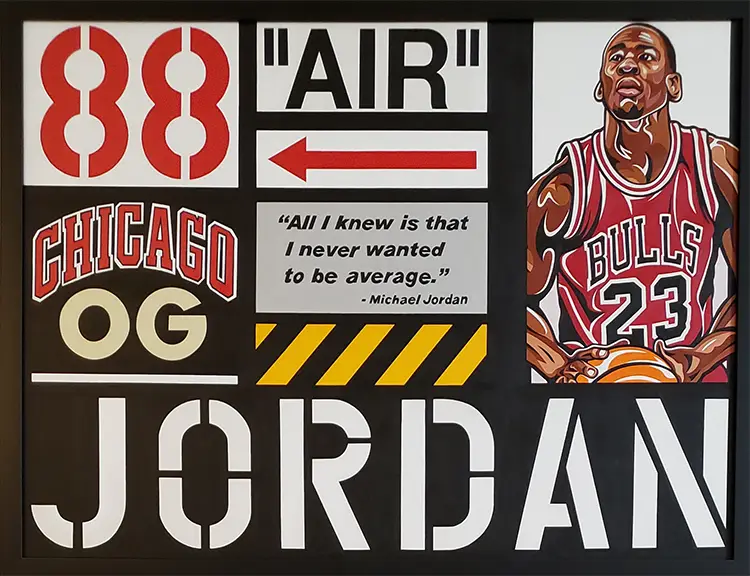
Fragments of Influence: Process, Practice, and Pop Icons
At the heart of Johnson’s creative process lies an intricate dance between discipline and inspiration. His studio is more than a physical space—it’s an engine fueled by sound, imagery, and research. Music pulses in the background while documentaries play on screens, surrounding him with voices and visuals that feed his thoughts. Platforms like Pinterest and Instagram serve as digital archives where Johnson sources references ranging from typography and logos to fashion and photography. These disparate inputs serve as ingredients in a mental collage that he assembles intuitively, piece by piece, until a cohesive concept emerges.
Concept development begins with this visual scavenging, and the real challenge lies in sorting and synthesizing the information. Johnson likens his approach to assembling a puzzle—selecting fragments of cultural imagery and aligning them into a coherent visual story. The goal is to trigger recognition while inviting reflection. His canvases might evoke familiar faces or pop references, but beneath the surface lies a layered narrative constructed from countless micro-decisions. It’s this balance of spontaneity and structure that defines his workflow. Rather than waiting for inspiration, Johnson imposes structure through self-directed timelines and mental exercises that counteract distraction and sharpen focus.
One of the most meaningful pieces in Johnson’s body of work is his painting of Mr. T, titled “I PITY THE FOOL.” For Johnson, Mr. T was more than a character—he was a symbol of strength and presence in the cultural atmosphere of the 1980s. That era, punctuated by Saturday morning cartoons and heroic TV personas, formed a critical part of Johnson’s creative foundation. The Mr. T painting encapsulates this era with uncanny accuracy, channeling the bold colors, exaggerated personas, and media saturation of the time. The work stands as a personal touchstone for Johnson, marking the convergence of his childhood joy and adult artistic clarity.

Michael E. Johnson: Paint, Pixels, and Possibility
While acrylic on canvas remains Johnson’s primary medium, his relationship with painting began with a gift—a canvas, brushes, and paint from his uncle, who also practiced art. That simple gesture unlocked a new dimension of expression, showing Johnson the expansive potential of scale and color. Acrylics, in particular, became his medium of choice due to their quick drying properties, allowing for an efficient and forgiving workflow. He embraced the adaptability of the medium, using it to layer, revise, and rework compositions without the constraints of permanence. Although he’s explored other tools like airbrush, pen, and colored pencil, acrylics continue to serve as the foundation of his current creative language.
Throughout his development, Johnson has drawn inspiration from a diverse roster of artists whose work commands instant recognition. From Andy Warhol and James Rosenquist to Nina Chanel Abney and Shepard Fairey, these artists exemplify the power of visual branding and thematic clarity. What connects them in Johnson’s mind is not only their technical mastery, but their distinctive voices—each piece an unmistakable signature. He studies their methods and applies the insights to his own journey, not to imitate, but to refine his individuality. These influences act as creative benchmarks, motivating him to continually elevate his voice within an increasingly saturated visual culture.
Looking forward, Johnson is captivated by the potential of technology to extend his practice into new dimensions. One project particularly close to his heart involves augmented reality: a collaborative concept in which viewers could scan his paintings through a mobile app, triggering animations and soundscapes that bring the work to life. Though the project is currently paused, its implications reflect Johnson’s visionary mindset. He’s not content to stay within the limits of the traditional canvas. Instead, he sees the future of art as interactive, immersive, and dynamic—where stories not only hang on the wall, but unfold in real time, engaging the senses and reshaping the way we experience creativity.
